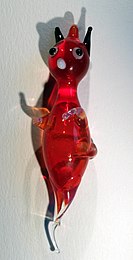
Back غواص ديكارتي Arabic Dimoniet de Descartes Catalan Cartesischer Taucher German Diablillo de Descartes Spanish غواص دکارتی Persian Ludion (physique) French Ludión Galician צוללן קרטזי HE Ludiono IO Diavoletto di Cartesio Italian
This article needs additional citations for verification. (January 2021) |
A Cartesian diver or Cartesian devil is a classic science experiment which demonstrates the principle of buoyancy (Archimedes' principle) and the ideal gas law. The first written description of this device is provided by Raffaello Magiotti, in his book Renitenza certissima dell'acqua alla compressione (Very firm resistance of water to compression) published in 1648. It is named after René Descartes as the toy is said to have been invented by him.[citation needed]
The principle is used to make small toys often called "water dancers" or "water devils". The principle is the same, but the eyedropper is instead replaced with a decorative object with the same properties which is a tube of near-neutral buoyancy, for example, a blown-glass bubble. If the tail of the glass bubble is given a twist, the flow of the water into and out of the glass bubble creates spin. This causes the toy to spin as it sinks and rises. An example of such a toy is the red "devil" shown here. The device also has a practical use for measuring the pressure of a liquid.
Plastic divers were given away in American cereal boxes as a free toy in the 1950s, and "Diving Tony," a version of the toy modelled after Kellogg's Frosted Flakes mascot Tony the Tiger, was made available in the 1980s.
